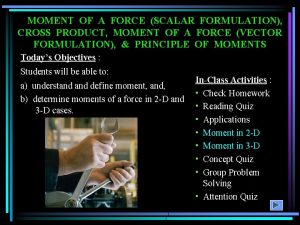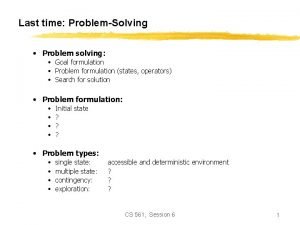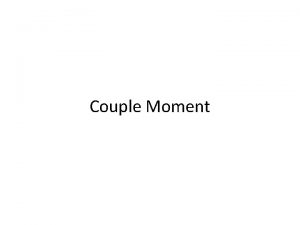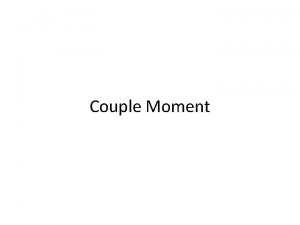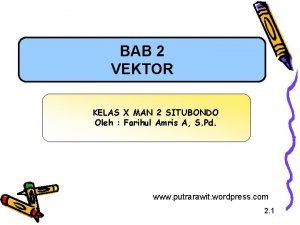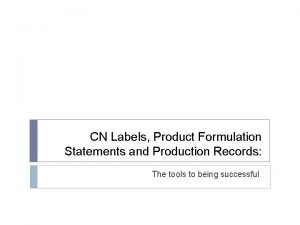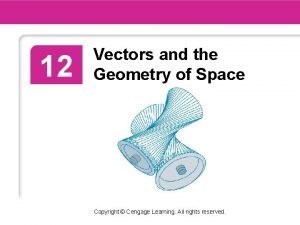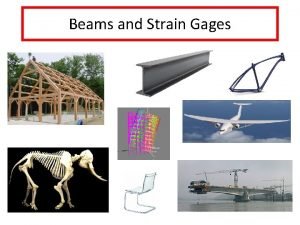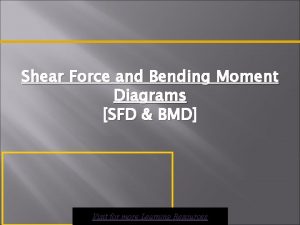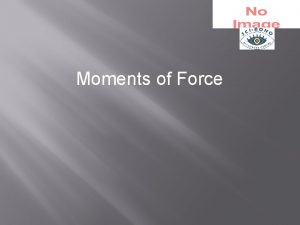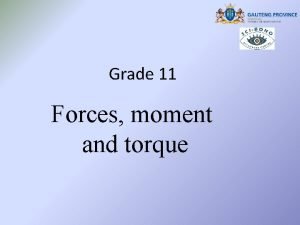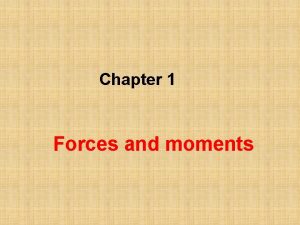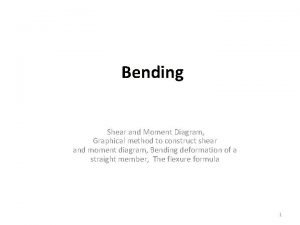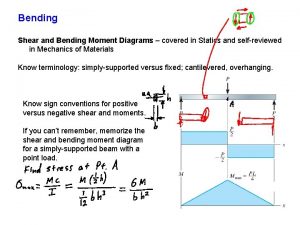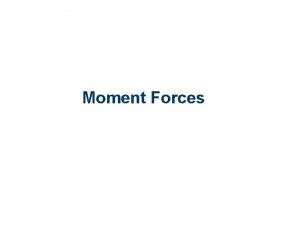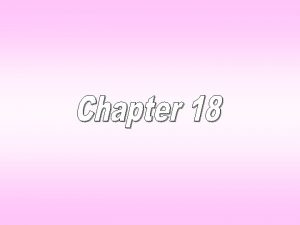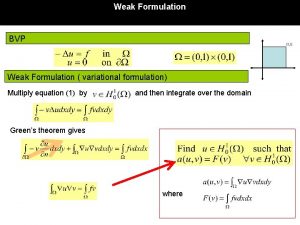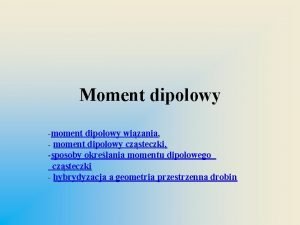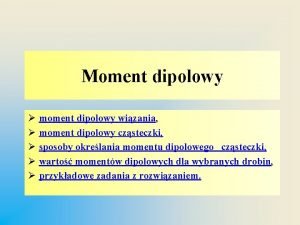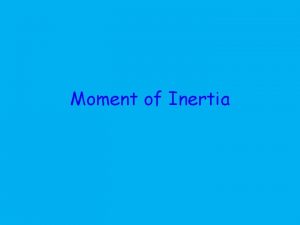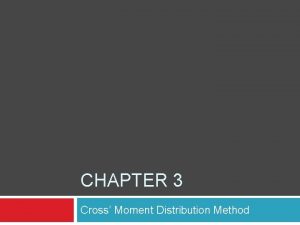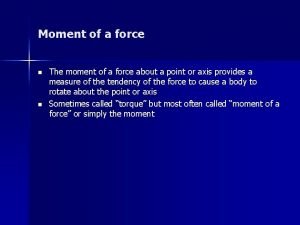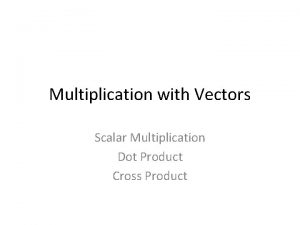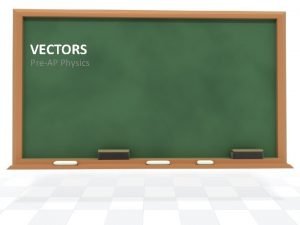MOMENT OF A FORCE SCALAR FORMULATION CROSS PRODUCT
























- Slides: 24

MOMENT OF A FORCE (SCALAR FORMULATION), CROSS PRODUCT, MOMENT OF A FORCE (VECTOR FORMULATION), & PRINCIPLE OF MOMENTS Today’s Objectives : Students will be able to: a) understand define moment, and, b) determine moments of a force in 2 -D and 3 -D cases. In-Class Activities : • Check Homework • Reading Quiz • Applications • Moment in 2 -D • Moment in 3 -D • Concept Quiz • Group Problem Solving • Attention Quiz

READING QUIZ F = 12 N 1. What is the moment of the 12 N force about point A (MA)? A) 3 N·m B) 36 N·m D) (12/3) N·m E) 7 N·m C) 12 N·m 2. The moment of force F about point O is defined as MO = ______. A) r x F B) F x r C) r • F D) r * F • A d=3 m

APPLICATIONS Beams are often used to bridge gaps in walls. We have to know what the effect of the force on the beam will have on the supports of the beam. What do you think is happening at points A and B?

APPLICATIONS (continued) Carpenters often use a hammer in this way to pull a stubborn nail. Through what sort of action does the force FH at the handle pull the nail? How can you mathematically model the effect of force FH at point O?

MOMENT OF A FORCE - SCALAR FORMULATION (Section 4. 1) The moment of a force about a point provides a measure of the tendency for rotation (sometimes called a torque).

MOMENT OF A FORCE - SCALAR FORMULATION (continued) In a 2 -D case, the magnitude of the moment is Mo = F d As shown, d is the perpendicular distance from point O to the line of action of the force. In 2 -D, the direction of MO is either clockwise (CW) or counter-clockwise (CCW), depending on the tendency for rotation.

MOMENT OF A FORCE - SCALAR FORMULATION (continued) F a For example, MO = F d and the b direction is counter-clockwise. O d Often it is easier to determine MO by using the components of F as shown. Fy b a F Fx O Then MO = (FY a) – (FX b). Note the different signs on the terms! The typical sign convention for a moment in 2 -D is that counterclockwise is considered positive. We can determine the direction of rotation by imagining the body pinned at O and deciding which way the body would rotate because of the force.

VECTOR CROSS PRODUCT (Section 4. 2) While finding the moment of a force in 2 -D is straightforward when you know the perpendicular distance d, finding the perpendicular distances can be hard—especially when you are working with forces in three dimensions. So a more general approach to finding the moment of a force exists. This more general approach is usually used when dealing with three dimensional forces but can be used in the two dimensional case as well. This more general method of finding the moment of a force uses a vector operation called the cross product of two vectors.

CROSS PRODUCT (Section 4. 2) In general, the cross product of two vectors A and B results in another vector, C , i. e. , C = A B. The magnitude and direction of the resulting vector can be written as C = A B = A B sin u. C As shown, u. C is the unit vector perpendicular to both A and B vectors (or to the plane containing the A and B vectors).

CROSS PRODUCT (continued) The right-hand rule is a useful tool for determining the direction of the vector resulting from a cross product. For example: i j = k Note that a vector crossed into itself is zero, e. g. , i i = 0

CROSS PRODUCT (continued) Also, the cross product can be written as a determinant. Each component can be determined using 2 2 determinants.

MOMENT OF A FORCE – VECTOR FORMULATION (Section 4. 3) Moments in 3 -D can be calculated using scalar (2 -D) approach, but it can be difficult and time consuming. Thus, it is often easier to use a mathematical approach called the vector cross product. Using the vector cross product, MO = r F. Here r is the position vector from point O to any point on the line of action of F.

MOMENT OF A FORCE – VECTOR FORMULATION (continued) So, using the cross product, a moment can be expressed as By expanding the above equation using 2 2 determinants (see Section 4. 2), we get (sample units are N - m or lb - ft) MO = (ry FZ - r. Z Fy) i (rx Fz - rz Fx ) j + (rx Fy - ry Fx ) k The physical meaning of the above equation becomes evident by considering the force components separately and using a 2 -D formulation.

EXAMPLE I Given: A 100 N force is applied to the frame. Find: The moment of the force at point O. Plan: 1) Resolve the 100 N force along x and y-axes. 2) Determine MO using a scalar analysis for the two force components and then add those two moments together. .

EXAMPLE I (continued) Solution + Fy = – 100 (3/5) N + Fx = 100 (4/5) N + MO = {– 100 (3/5)N (5 m) – (100)(4/5)N (2 m)} N·m = – 460 N·m or 460 N·m CW

EXAMPLE II Given: F 1={100 i - 120 j + 75 k}lb F 2={-200 i +250 j + 100 k}lb o Find: Resultant moment by the forces about point O. Plan: 1) Find F = F 1 + F 2 and r. OA. 2) Determine MO = r. OA F.

EXAMPLE II (continued) Solution: First, find the resultant force vector F F = F 1 + F 2 = { (100 - 200) i + (-120 + 250) j + (75 + 100) k} lb = {-100 i +130 j + 175 k} lb Find the position vector r. OA = {4 i + 5 j + 3 k} ft Then find the moment by using the vector cross product. i 4 j k MO = 5 3 = [{5(175) – 3(130)} i – {4(175) – 3(-100)} j + {4(130) – 5(-100)} k] ft·lb -100 130 175 = {485 i – 1000 j + 1020 k} ft·lb

CONCEPT QUIZ 1. If a force of magnitude F can be applied in four different 2 -D configurations (P, Q, R, & S), select the cases resulting in the maximum and minimum torque values on the nut. (Max, Min). A) (Q, P) B) (R, S) C) (P, R) D) (Q, S) 2. If M = r F, then what will be the value of M • r? A) 0 B) 1 C) r 2 F D) None of the above.

GROUP PROBLEM SOLVING I y x Given: A 20 lb force is applied to the hammer. Find: The moment of the force at A. Plan: Since this is a 2 -D problem: 1) Resolve the 20 lb force along the handle’s x and y axes. 2) Determine MA using a scalar analysis.

GROUP PROBLEM SOLVING I (continued) y x Solution: + Fy = 20 sin 30° lb + Fx = 20 cos 30° lb + MA = {–(20 cos 30°)lb (18 in) – (20 sin 20°)lb (5 in)} = – 351. 77 lb·in = 352 lb·in (clockwise or CW)

GROUP PROBLEM SOLVING II Given: The force and geometry shown. Find: Moment of F about point A Plan: 1) Find F and r. AC. 2) Determine MA = r. AC F

GROUP PROBLEM SOLVING II (continued) Solution: F ={ (80 cos 30) sin 40 i + (80 cos 30) cos 40 j 80 sin 30 k} N ={44. 53 i + 53. 07 j 40 k } N r. AC ={0. 55 i + 0. 4 j 0. 2 k } m Find the moment by using the cross product. i j k MA = 0. 55 0. 4 0. 2 44. 53 53. 07 40 = { -5. 39 i + 13. 1 j +11. 4 k } N·m

ATTENTION QUIZ 10 N 3 m P 2 m 5 N 1. Using the CCW direction as positive, the net moment of the two forces about point P is A) 10 N ·m B) 20 N ·m C) - 20 N ·m D) 40 N ·m E) - 40 N ·m 2. If r = { 5 j } m and F = { 10 k } N, the moment r x F equals { _______ } N·m. A) 50 i B) 50 j D) – 50 j E) 0 C) – 50 i

 Scalar formulation
Scalar formulation Moment of a force-scalar formulation
Moment of a force-scalar formulation Why problem formulation follow goal formulation
Why problem formulation follow goal formulation Ft lbs to nm
Ft lbs to nm Formula
Formula Moment about axis
Moment about axis Formula for couple
Formula for couple Outer product
Outer product Sifat perkalian dot vektor
Sifat perkalian dot vektor Rumus yang menyatakan cross product adalah ...
Rumus yang menyatakan cross product adalah ... Product formulation statement
Product formulation statement Product formulation statement
Product formulation statement Product formulation statement example
Product formulation statement example Centripetal acceleration vector or scalar
Centripetal acceleration vector or scalar Scalar product of vectors
Scalar product of vectors Cara mencari hasil kali skalar
Cara mencari hasil kali skalar Vectors and the geometry of space
Vectors and the geometry of space Cross section moment of inertia
Cross section moment of inertia Sfd and bmd
Sfd and bmd Moment of force example
Moment of force example Moment of a force
Moment of a force Torque definition
Torque definition Is a moment a force
Is a moment a force Shear force and bending moment diagrams graphical method
Shear force and bending moment diagrams graphical method Bending moment direction
Bending moment direction
